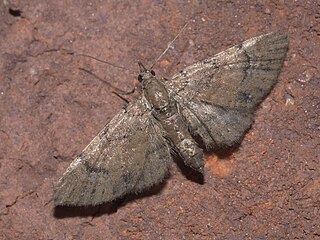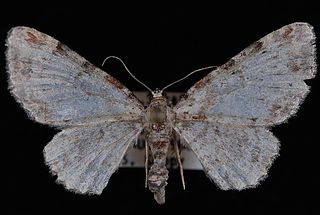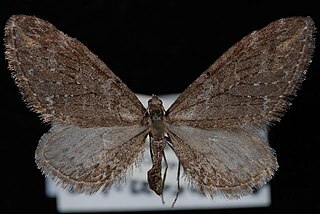
Eupithecia satyrata, the satyr pug, is a species of moth of the family Geometridae. It was described by Jacob Hübner in 1813. It is found from Ireland, through northern and central Europe east to all of Russia and central Asia and western Siberia to Tibet. It is also present in North Africa and North America.

Eupithecia peckorum, or Peck's pug moth, is a moth in the family Geometridae. The species was first described by Roger L. Heitzman and Wilbur R. Enns in 1977. It is found in the United States in eastern Texas, Missouri, Mississippi and Louisiana.
Eupithecia herefordaria, or Hereford's eupithecia, is a moth in the family Geometridae. It is found in south-eastern Arizona, United States.
Eupithecia cupressata is a moth in the family Geometridae. It is found in the Alameda, Mendocino, and Monterey counties in central coastal California.

Eupithecia cimicifugata is a moth in the family Geometridae first described by Pearsall in 1908. It is found in North America, including Alberta, Ontario, Saskatchewan, Kentucky, Maryland and South Dakota.
Eupithecia nimbosa is a moth in the family Geometridae first described by George Duryea Hulst in 1896. It is widespread in the Rocky Mountains, from Arizona to the Canada–US border.

Eupithecia mutata, the spruce cone looper or cloaked pug, is a moth in the family Geometridae. The species was first described by Pearsall in 1908. It is found in the northern Atlantic and New England states in North America. In Canada, the range extends from Nova Scotia to northern Ontario.
Eupithecia classicata is a moth in the family Geometridae first described by Pearsall in 1909. It is found in the US state of Arizona and the Mexican state of Durango.

Eupithecia misturata is a moth in the family Geometridae first described by George Duryea Hulst in 1896. It is widely distributed in western North America.

Eupithecia affinata is a moth in the family Geometridae first described by Pearsall in 1908. It is found in North America, including Pennsylvania, New Jersey, New York, Maryland, Maine, Michigan, North Carolina, West Virginia, Kentucky, Ontario and Quebec. It has also been recorded from Arizona and California.
Eupithecia piccata is a moth in the family Geometridae first described by Pearsall in 1910. It is found in the US states of Arizona and New Mexico.
Eupithecia exudata is a moth in the family Geometridae first described by Pearsall in 1909. It is found in the eastern United States, including Pennsylvania, Indiana, Kentucky and Ohio.
Eupithecia segregata is a moth in the family Geometridae first described by Pearsall in 1910. It is found in the US states of Oregon, Arizona and California.
Eupithecia cocoata is a moth in the family Geometridae. It is found in North America, with records from Maryland, Iowa and Washington.
Eupithecia purpurissata is a moth in the family Geometridae first described by John Arthur Grossbeck in 1908. It is found in the US state of California.

Eupithecia scabrogata is a moth in the family Geometridae first described by Pearsall in 1912. It is found in western North America from British Columbia to California and Arizona.
Eupithecia adequata is a moth in the family Geometridae first described by Pearsall in 1910. It is found in the United States from Utah and Colorado through Nevada to California and Arizona.
Nasusina vaporata is a moth in the family Geometridae first described by Pearsall in 1912. It is found in the United States in southern California, Nevada and probably Arizona.
Prorella insipidata is an American moth of the family Geometridae first described by Pearsall in 1910. It lives in Oregon, California, Arizona, New Mexico and Texas.
Prorella opinata is a moth in the family Geometridae first described by Pearsall in 1909. It is found in the US states of Colorado, California, Arizona, New Mexico and Utah.






